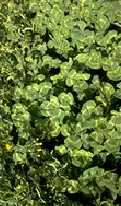View crop
View crop Data sheet EcoPortTrifolium subterraneum
 |
|
| Notes |
|---|
| BRIEF DESCRIPTION A prostrate herbaceous legume reaching 15-30 cm in height branching from the base with a relatively strong tap root, white flowers, and pods composed of a network of fibres each containing one seed. USES Provides good pasture when mixed with grasses, hay and silage. It also provides good erosion control. KILLING T Well-established seedlings can survive -15°C. GROWING PERIOD Annual. Autumn sown in Brazil, it provides groundcover in 90-115 days, flowers after 95-130 days, and mature in 140-190 days. In the United States, it is sown in September-October, flowers in April-May and fruit in May-June. Season for green forage is usually March-July. In the southern United States, it makes permanent pastures lasting up to 25 years. It propagate itself by seed. COMMON NAMES Subterranean clover, Subclover, Trevo subterraneo, Subterranean trefoil, Trefle souterraun, Tefle semeur, Beid-diez-zouch, El-nefel, El ardhi. FURTHER INF Scientific synonyms: T. oxaloides. Subterranean clover is indigenous to the Mediterranean region. It is best suited to regions with mild winters and warm, dry summers. In northern Africa and western Asia it can be found on humid soils of open plains and in mountains at elevations between sea level and 1800 m. Yields of green forage may be about 35-40 tha. | Sources |
| Grassland Index Heath M 1985 pp 142-143 [RAIN, PH, LIG] Duke J 1981 pp 262-265 320 [TEXT, DRA, RAIN, TEMP, PH] Roecklein J 1987 pp 183 [USE] Kernick M 1961 pp 38 Monegat C 1991 pp 119 Langer R 1991 pp 230-232 [RAIN] Kernick M 1978 pp 623-656 [TEMP, RAIN, PH] |